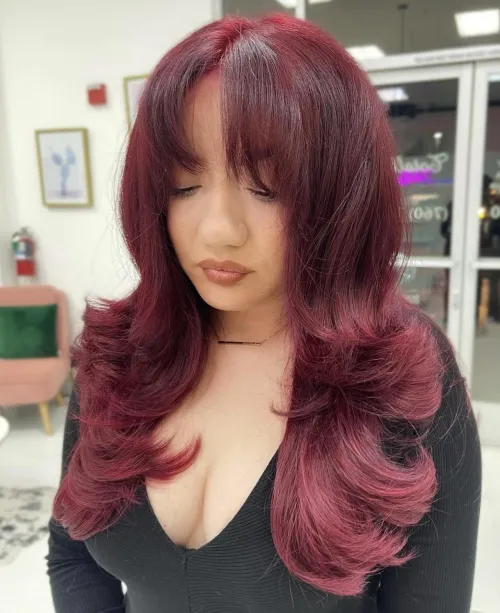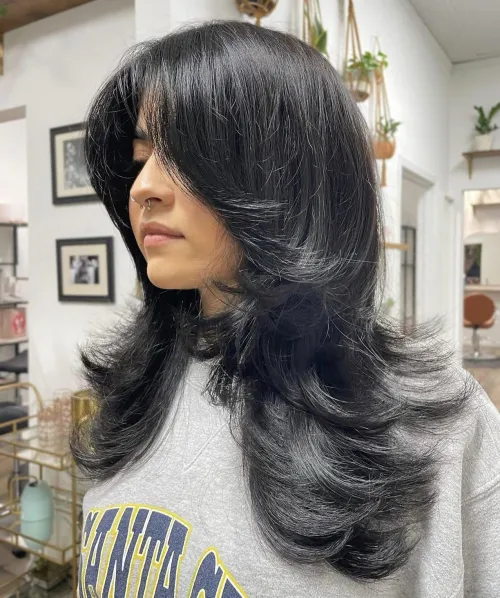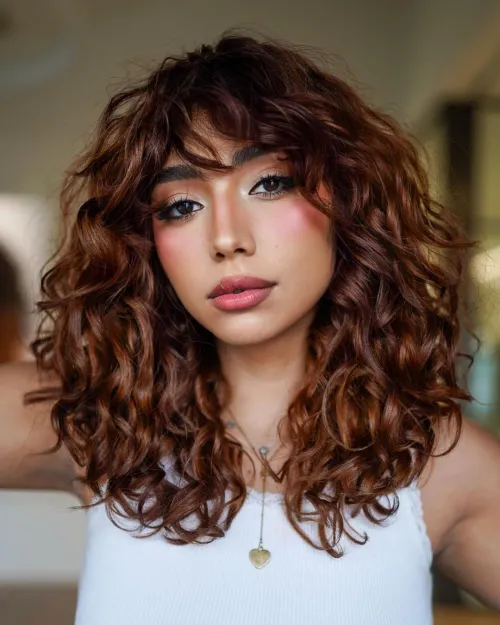Who doesn’t love a good hair makeover? Something about the process of recreating ourselves and trying new things just feels invigorating, doesn’t it? And when it comes to hair, one of the best ways to switch things up is with layers.
Layers add depth, texture, and movement to your locks, giving you an effortlessly chic look. But with so many different types of layers out there, it can be hard to decide which one is right for you. So, in this post, we’ll be taking a look at 10 types of hair layers that you need to try to give you some inspiration for your next salon appointment!
10 Types of Hair Layers
1. Wispy Layers
The wispy cut is one of my personal favorites. When I envision wispy, I visualize a hairstyle that exudes a sense of lightness and airiness. If you desire a hairstyle that appears lightweight and creates an airy effect, the wispy cut is the perfect choice.
For a customized version of this cut, I incorporated bangs, a heavy face frame, and wispy layers, resulting in a soft and graceful movement that complements a joyful and carefree demeanor. This tailored approach adds an extra touch of charm to the overall look.

2. Textured Layers
In hairstyling, the process of creating layers involves using either a razor or shear. To achieve a texturized look, it is crucial to use a texturizing shear to cut the interior or ends of the layers. By doing so, the additional weight that hampers movement and bounce in your haircut is removed. Consequently, your hair will have increased vitality and enhanced shape.

3. Flippy Layers
Flippy layers are a popular hairstyling technique that originated in the 70s, creating a unique “flipped” look. To achieve this style, begin by creating a base cut on wet hair, followed by a blowout.
However, it’s important to note that the cut is not yet completed or flipped after the blowout. Once the hair is fully dry and styled, proceed to perfect the cut using straight shears and texturizing shears. Only after the dry cut can the layers be flipped to achieve the desired outcome.
Finishing off with a dry cut after styling allows for a better assessment of the haircut’s true shape. Seeing the shape and flip of the layers is not possible when the hair is wet. Therefore, the cut and blowout style work in harmony when creating flippy layers.
Moreover, it’s worth mentioning that the flippy layered trend is not limited to medium or bob hair lengths. With the right cutting technique and styling approach, it’s possible to achieve the trendy flippy look even with long hair.

4. Choppy Layers
The bold and trendy haircut consists of several key elements. It starts with incorporating baby bangs, which are shorter in length and add a unique touch to the overall look. Additionally, a heavy face frame is created to accentuate facial features. To enhance the texture and style of the haircut, tons of choppy layers are added, giving it a distinct and edgy appearance. These choppy layers are intentionally shorter in length and create a deliberate contrast rather than blending seamlessly with the rest of the hair. Overall, this haircut is a fashionable choice for those looking to make a statement with their hairstyle.

5. Feathered Layers
Feathered haircuts are a styling technique that allows layers to gracefully cascade away from the face, creating a light and feathery effect. One main focal point of this hairstyle is the ends, which are meticulously styled to achieve the desired look.
In the example below, I applied this technique by incorporating curtain bangs and thinning out the ends. This not only reduced bulk but also enhanced the flow of the hair away from the face, resulting in a captivating feathery illusion.
Feathered haircuts are a versatile and trendy choice for those looking to add movement and texture to their hair. With careful attention to detail and skilled hairdressing techniques, a professional stylist can help you achieve the desired feathery look that perfectly suits your style and personality.

6. Short vs Long Layers
Haircuts with short layers offer ample space for volume, particularly in the crown area, resulting in enhanced movement and flow throughout the entire cut. It is important to note that longer layers tend to be heavier, which can reduce both movement and volume at the crown.
For instance, in the case of this client, I opted for shorter layers at the crown to emphasize her natural silhouette. This choice created a more tapered look that accentuates her jawline and enhances her natural features, providing a sophisticated and stylish appearance.

7. Invisible Layers
If you desire your hair color to be the focal point, consider opting for invisible layers. Invisible layers, as the name suggests, are discreetly incorporated into the haircut and are mostly hidden from view. These layers are typically longer in length, and the majority of the hair work is performed on the interior sections.
The primary purpose of invisible layers is to eliminate excess hair and enhance the natural movement of the hair. This haircut is highly recommended for individuals seeking a more effortless and organic finished look.

8. Face Framing Layers
Face framing layers are a versatile haircut technique where layers are strategically placed near or slightly below the jawline. These layers serve to soften facial features and can beautifully enhance your natural beauty. Moreover, this particular cutting style can help create a slimming effect on your face, resulting in an overall flattering look that complements your unique features.

9. U vs V Cut Layers
When cutting layers into longer hair, stylists have the option to create either a U-shaped or a V-shaped cut. The distinction lies in how the hair falls down the back, creating the appearance of a soft U or a more defined V-like shape. Additionally, when the hair is pulled forward, the shorter layers will gracefully frame the face and extend past the shoulders, further enhancing the overall look and style.

10. Layers for Curly Hair
Layers in curly hair have several benefits. They help create a nice form, improve bounce, and most importantly, avoid an awkward triangle cut look. When you’re considering layering your curly hair, it is important to choose between longer layers and a curly shag. The curly shag typically includes curly bangs and shorter layers around the crown.
It goes without saying that finding a stylist who specializes in cutting curly hair is vital. Not only will they help you choose the best type of layers, but they will also teach you the proper hair styling routine to follow. This is crucial for maintaining the health and appearance of your curly locks.

How to Style Your Layers?
To create a professional salon look at home and accentuate your layered cut, it’s important to have the right styling products. Instead of using hair sprays, opt for hair creams when doing blowouts. Prior to blow drying, use an anti-frizz cream and a heat protectant cream to ensure smoothness and protection for your hair.
To achieve bounce and volume for your layered cut, you have several options. You can use a round brush, a blow dryer brush, or heat rollers. After blow drying, run your fingers through the ends of your hair, and for an added touch, apply a lightweight hair oil to smoothen and enhance shine to your blowout.

